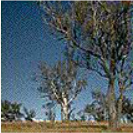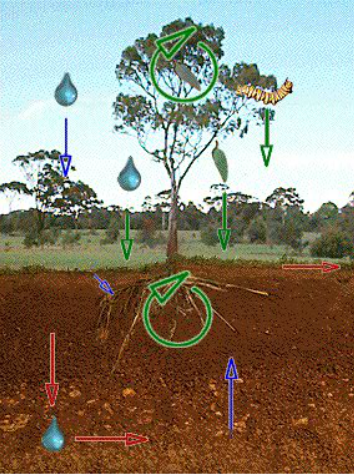Nutrient Cycling: Paths and Processes
Nutrient cycling includes nutrient returns such as internal recycling, litterfall, decomposition and uptake,
nutrient inputs such as deposition and weathering, and nutrient losses such as leaching and runoff.
The rate and magnitude of each of these varies for different elements according to their abundance,
their mobility and plant requirements
Move the mouse over and click the diagram for explanations of some of the major flows and processes involved in nutrient cycling. Green arrows represent nutrient returns, blue inputs and red losses...
Leaching & Streamflow
Nutrients are leached by water moving down the soil profile. Eventually they move beyond the root zone and may reach the watertable. Lateral movement of soil water carries dissolved nutrients into streams.

A fast flowing forest stream fed by surface runoff and soil drainage.
Weathering
The parent material is slowly weathered over time by chemical and physical action, releasing nutrients. Weathering is the major source of soil phosphorus and also contributes substantial quantities of Ca, Mg and K. However, its contribution to plant uptake depends on the type of parent material, and depth at which it occurs. Leaching removes some nutrients released by weathering.
Decomposition & Uptake
Organic matter, which comprises aboveground litter, dead roots and the remains of soil organisms, must be considerably broken down (or mineralised) before the nutrients it contains are available for uptake by a plant's roots.
Runoff
Nutrients are washed into streams by surface runoff, which can be high, even in arid environments, if rainfall is intense. Nutrient losses tend to be greatest following disturbances such as fire when the mineral soil is exposed.

A fast flowing forest stream fed by surface runoff and soil drainage.
Litterfall
Litterfall includes the leaves, twigs branches and bark shed by plants and is the main method of nutrient return. The litterfall of eucalypt forests varies between 1 and 10 t/ha/yr with about 50% of this contributed by leaves. Although litterfall occurs throughout the year it shows a distinct summer peak in southern Australia.

Litter build-up at the base of a mature Eucalyptus regnans.
Insect frass
Frass or excreta from herbivorous insects and mammals is comparatively easily broken down resulting in rapid nutrient return. Although the proportion of nutrients returned by this pathway is generally small, whole tree crowns can be defoliated during insect outbreaks.

Defoliation of forest redgum, (Eucalyptus tereticornis) by cockchaffer beetles in Gippsland, Victoria.
Internal recycling
Many elements are recycled within the plants, withdrawn from older tissues and redirected to sites of higher demand. Phosphorus and nitrogen are relatively mobile elements and up to 60% of each is withdrawn from eucalypt leaves prior to leaf-fall. Calcium, however, is structually bound and highly immobile and occurs at high concentrations in plant litter.

Newly expanded before foliage of Antarctic beech (Nothofagus cunninghamii)
Nutrient accession in rainfall
Rainfall is an important source of nutrients to many ecosystems. While phosphorus is added in only trace amounts rainfall can contribute up to several kg/ha/yr of N, K, Ca and Mg (amounts tend to be highest near the coast.)
Leaching
Nutrients, which include carbohydrates, amino and organic acids as well as inorganic ions are dissolved and leached as rainwater passes through the tree crown. For example, more than half the initial Na+ and K+ content of leaves may be lost through leaching up until leaf fall.
Nitrogen-fixation
Biological nitrogen-fixation can add from a few to tens of kgs of nitrogen to the soil each year. In legumes and other plants which for symbioses with N-fixing microorganisms, this nitrogen is 'delivered' directly to the plant's roots.
See the section on N-fixation for further information...

